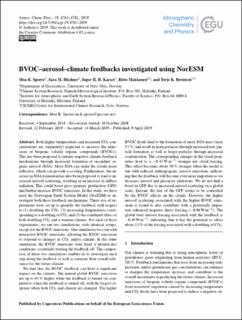| dc.contributor.author | Sporre, Moa Kristina | |
| dc.contributor.author | Blichner, Sara Marie | |
| dc.contributor.author | Karset, Inger Helene H. | |
| dc.contributor.author | Makkonen, Risto | |
| dc.contributor.author | Berntsen, Terje Koren | |
| dc.date.accessioned | 2021-06-17T10:27:59Z | |
| dc.date.available | 2021-06-17T10:27:59Z | |
| dc.date.created | 2019-06-19T13:01:49Z | |
| dc.date.issued | 2019 | |
| dc.identifier.citation | Atmospheric Chemistry and Physics. 2019, 19 (7), 4763-4782. | en_US |
| dc.identifier.issn | 1680-7316 | |
| dc.identifier.uri | https://hdl.handle.net/11250/2759934 | |
| dc.description.abstract | Both higher temperatures and increased CO2 con centrations are (separately) expected to increase the emis sions of biogenic volatile organic compounds (BVOCs). This has been proposed to initiate negative climate feedback mechanisms through increased formation of secondary or ganic aerosol (SOA). More SOA can make the clouds more reflective, which can provide a cooling. Furthermore, the in crease in SOA formation has also been proposed to lead to in creased aerosol scattering, resulting in an increase in diffuse radiation. This could boost gross primary production (GPP) and further increase BVOC emissions. In this study, we have used the Norwegian Earth System Model (NorESM) to in vestigate both these feedback mechanisms. Three sets of ex periments were set up to quantify the feedback with respect to (1) doubling the CO2, (2) increasing temperatures corre sponding to a doubling of CO2 and (3) the combined effect of both doubling CO2 and a warmer climate. For each of these
experiments, we ran two simulations, with identical setups, except for the BVOC emissions. One simulation was run with interactive BVOC emissions, allowing the BVOC emissions to respond to changes in CO2 and/or climate. In the other simulation, the BVOC emissions were fixed at present-day
conditions, essentially turning the feedback off. The compar ison of these two simulations enables us to investigate each step along the feedback as well as estimate their overall rele vance for the future climate..... | en_US |
| dc.language.iso | eng | en_US |
| dc.publisher | AGU | en_US |
| dc.rights | Navngivelse 4.0 Internasjonal | * |
| dc.rights.uri | http://creativecommons.org/licenses/by/4.0/deed.no | * |
| dc.title | BVOC-aerosol-climate feedbacks investigated using NorESM | en_US |
| dc.type | Journal article | en_US |
| dc.type | Peer reviewed | en_US |
| dc.description.version | publishedVersion | en_US |
| dc.source.pagenumber | 4763-4782 | en_US |
| dc.source.volume | 19 | en_US |
| dc.source.journal | Atmospheric Chemistry and Physics | en_US |
| dc.source.issue | 7 | en_US |
| dc.identifier.doi | 10.5194/acp-19-4763-2019 | |
| dc.identifier.cristin | 1706073 | |
| cristin.unitcode | 7475,0,0,0 | |
| cristin.unitname | CICERO Senter for klimaforskning | |
| cristin.ispublished | true | |
| cristin.fulltext | original | |
| cristin.qualitycode | 2 | |

